15
By Keelan Boyle, Frank Ford, and Daniel Shea
Introduction:
It’s early in the morning of March 28th, 1979. Alarms are blaring on Three Mile Island in Pennsylvania, indicating that something went wrong in one of the nuclear reactors. Reactor one had begun normal maintenance work which led to the second of the three reactors to run at higher-than-normal capacity. A blockage in the water filtration system was unable to be cleared and led to an influx of a water/steam bubble mixture into the reactor (NRC, 2018). High pressure triggered a relief valve on top to open to relieve pressure. This valve should normalize the pressure in less than 20 seconds, however, it remained open for 142 minutes and the operators failed to notice due to a faulty indicator that had implied the relief valve had closed (Murray, 2014).
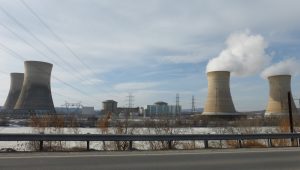
This caused radioactive water to the containment floor and radioactive gases out into the world through ventilation systems. This release, however, was so miniscule that those within a 50-mile radius, if exposed over a lifetime only one additional cancer death would occur. This proved to be a perfect example of the importance of quality operator training and design efficiency (Murray, 2014). Several well-known disasters at nuclear energy plants have left a stain on the public’s view of nuclear energy and while nuclear energy has some dangerous negative effects, the benefits of this form of safe and clean sustainable energy outweigh the costs.
One of the main issues with nuclear energy is that the history of nuclear power is almost all negative. The process used to create clean energy was once originally used for the sole purpose of destroying. Nuclear power conjures up images of World War II and the race to create the atomic bomb, a bomb with greater power and more devastating consequences than anything the world had previously seen.
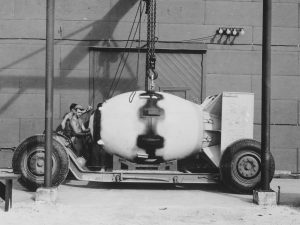
`The history behind this form of power is riddled with death, destruction, and lasting consequences, however, the discovery of clean energy from nuclear power could have changed public perception. Due to a few accidents the public opinion of this form of clean energy was changed for decades. Chernobyl, Three Mile Island and Fukushima Daiichi are the three main disasters that led to such a negative view of nuclear energy. With time, advancements in safety and a new type of generation, nuclear energy has started to come back into positive light. A new understanding of nuclear energy has led to a push for the reinstatement of many nuclear plants that should be considered with great interest by governments and the public once again.
This project was intended to address the negative stigmas associated with nuclear energy. In the beginning, this group viewed nuclear energy as a somewhat dangerous and mysterious form of clean energy. Opinions shaped by past disasters and a more recent devastating disaster in Fukushima, Japan led to discussion on nuclear power. From this stemmed curiosity about if these views were justified or if this form of sustainable energy was rather one of the most promising electricity producing technologies we have on Earth. Questioning preconceived notions led to a new understanding of the topic, a topic which has the potential to fight climate change by reducing carbon emissions. The hope of this project is to educate the masses on how the expansion of nuclear power, if done correctly, would have benefits that greatly outweigh the risks.
The History of Nuclear Power:
During the cold war there was a nuclear arms race between the United States and the USSR. One of the largest breakthroughs at that time was the discovery of the process known as fission. Fission made it possible to forcibly split an Urianum-235 atom by firing a neutron at the atom (as seen in figure 3). This process released a large amount of energy which made it possible to make bigger and more destructive bombs. This led to the field of nuclear science (Gale, 2020).
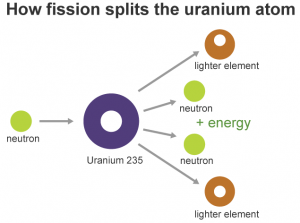
While many during this time concentrated their efforts on creating destructive devices some became interested in turning the destructive power of fission into electricity. This led to the construction of the first nuclear reactors but this new technology, however potential, it was linked to destruction and war in the mind of the public. This made implementing this potentially dangerous technology exceedingly difficult, but with educating the public through a variety of means the public grew to understand and accept nuclear energy (Dewan, 2019). This changed with the failures of two notable reactors: Chernobyl and Fukushima Daiichi (Chater, 2005). Even though these tragedies were significant in the evolution of nuclear power, there was a remarkably low loss of life associated with a nuclear reactor meltdown (UNSCEAR, 2008). The stigmas originating during the second world war were once revitalized as the world witnessed the risks associated with nuclear power. One may wonder though, if the influence of the atomic bomb and nuclear power plant failures are the only causes of negative stigmas against nuclear power. It has been found, however that many other factors influence people’s opinion on the topic at hand.
Several of the main stigmas of nuclear energy come from governmental concerns. Those who hold a distrust in their country’s government or society tend to lean away from the idea of nuclear energy, especially if the government is promoting the idea. One example of this is in South Korea, which, statistically, has lowest overall level of social trust, which is defined as the belief that others in a society can be trusted (Kim, 2018). South Korean citizens particularly dislike how the nuclear power program has been a national organization since the 1970s. As a result, they have a particular distaste in nuclear energy options, since installing nuclear power plants is already a risky proposition. Despite this, the country uses nuclear power to generate 26.9% of South Korea’s electricity as of 2017 (Kim, 2018).
Environmental concerns additionally play a role, as studies have shown that individuals with biospheric values, that is, they value the environment, tend to disagree with the idea of using nuclear energy, since their risk perception of the matter is higher (De Groot, 2013). In the minds of people who hold these values, the number of radioactive accidents that have occurred in the past few decades overshadows the fact that nuclear energy has no carbon emissions and uses land more efficiently than other types of renewable energy.
Finally, peoples’ life experiences, as well as their values, play a huge role in forming their opinions about nuclear energy. Jim De Groot studied three major life values when evaluating peoples’ perceived risks, benefits, and acceptability of nuclear energy: egoistical, altruistic, and biospheric. Egoistical people, like nuclear energy, obtain a general dislike from members of society. Egoistical people tend to put their own needs first rather than thinking about others, and they tend to be self-centered. These types of people have a high benefit perception of nuclear energy, meaning they see more benefits involved than risks. On the contrary, altruistic people strive to bring advantages for others, even if they get hurt from the results. These types of people are very selfless. Finally, biospheric people are those whose main values center around the environment and preserving mother nature (Wang, 2021). Both altruistic and biospheric people have an elevated risk perception of nuclear energy, believing that it includes more risks than benefits (De Groot, 2013). Demographic statistics, such as gender, income, and education, as well as benefit perception, and trust, affects peoples’ views on nuclear energy, with men, those with higher education, and those with lower income having a higher benefit perception towards nuclear energy.
Positives
Over the past 30 years, nuclear energy has demonstrated the ability to produce electricity at a low, predictable, and stable cost due to its low dependence on the price of uranium. Furthermore, uranium is a widely distributed natural resource that many countries have access to. Consequently, it would be unlikely that uranium mining would lead to the international tensions we see today for oil or gas (Poinssot et al., 2014). The effect that nuclear energy could potentially have on developed countries foreign policy, specifically the United States, may be immense. The need to rely on unstable countries for oil has led in part to many recent conflicts and if those could be avoided it would benefit both the dependent and independent.
While uranium is widespread throughout the known world, the overall supply of the resource is anticipated to last only a few decades if current nuclear waste or spent fuel storage methods are continued. The ability to use spent fuel for secondary purposes through recycling would allow for nuclear energy to become the world’s main energy source (Hannum & Stanford, 2005). The recycling of spent fuel is not too far in the future, however, as France has already began doing so. They have standardized their nuclear reactors designs into three simple types: the three-loop 900 MWe (34 reactors), four-loop 1300 MWe (20 reactors) and four-loop 1450 MWe (4 reactors). By doing this they can more efficiently manage spent fuel (Krikorian, 2019). They manage this fuel through recycling, the process of recycling spent fuel lies in converting plutonium, a byproduct of fission in nuclear power plants, and uranium into a mixed oxide. This oxide can then be used again in nuclear power plants as fuel. This recycling has allowed France to reuse about 23,000 tons of fuel. This amount of fuel has been able to power them for an additional 14 years (Krikorian, 2019). France has shown the enormous benefits of reusing spent fuel, not only for limiting high level nuclear waste, but also limiting its natural uranium usage and thus promoting France’s energy independence.
Although France is a prime example of what other countries should begin to do, right here in the United States a new generation reactor and process would allow for nuclear energy to be more efficient. A safer and more sustainable nuclear energy cycle has been designed to be more efficient and effective. This design would use faster moving neutron atoms. This process allows for all the uranium atoms to be dissolved and converted to energy therefore eliminating much of the spent fuel produced today (Hannum et al., 2005). Additionally, this type of new generation reactor would be able to consume recycled fuel produced in slower moving, older generation, thermal neutron reactors. This potential technology would finally reduce long lived waste by producing waste that has a radioactive half-life of only about a hundred years (compared to thousands of years). This process could support nuclear energy generation indefinitely (Hannum et al., 2005). This would allow for the most efficient and effective use of Earth’s available uranium resources.
Another promising technology of nuclear energy is the process of fusion to create energy. Fusion is the process of combining deuterium and tertium (isotopes of Helium) to form hydrogen. This happens only when the D-T (tertium-deuterium) mixture is heated to extreme temperatures, upwards of 100 million degrees Celsius. Once heated to this temperature the two isotopes of Helium create a plasma, the fourth state of matter, which is simply a hot electrically charged gas. Once in this state, the environmental conditions necessary to overcome the electrostatic repulsion are satisfied and a strong nuclear force binds the nucleons together in the nucleus, thus starting a quantum mechanical tunneling process and forming hydrogen (see figure 4) (Kikuchi et al., 2012). The resulting hydrogen is lighter than the D-T mixture resulting in a release of heat energy, which is then used to heat water to make steam, turn a turbine and finally generate electricity. This process has been demonstrated in small reactors around the world but has been proven inefficient at a small scale.
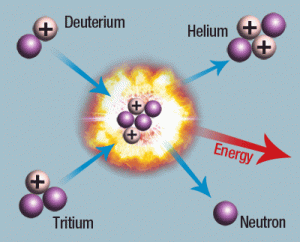
This discovery led to international agreements that a large fusion reactor must be built collaboratively. The International Thermonuclear Experimental Reactor (ITER) agreement was signed on November 21st, 2006. It was a formal agreement that committed China, the European Union, India, Japan, Korea, Russia and the United States to building the world’s first effective nuclear fusion power plant. The ITER organization was officially established on October 24th, 2007 after the ITER agreement was ratified in each participating country (Ikeda, 2009). This massive plant located in Southern France will be the first efficient nuclear fusion power plant. The predictions of the energy output of ITER is 500 MW of thermal power for 400-600 second periods for the 50 MW of input energy. This is a tenfold return compared to the current record output of 0.67% held by the JET tokamak in England (Dhar, 2020). ITER is currently 72.1% complete and is anticipated to be finished by 2025. At this time plasma will begin to be created and by 2035 the plant will begin efficiently producing energy (Dhar, 2020).
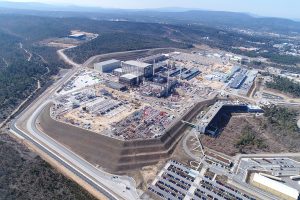
Once completed, this power plant will not only be efficient it will also produce significantly less waste and this waste will have a short half-life, making it less dangerous than traditional nuclear waste. Additionally, the ITER plant will have no risk of a nuclear meltdown contrary to current fission reactors (Ikeda, 2009). Finally, similarly to nuclear fission plants, ITER and all future fusion plants will release zero carbon emissions making it more ecofriendly than other renewable energy.
To further prove the point that nuclear energy is more ecofriendly than renewable energy, a case study was examined. In the case study, done from 1984-2007, 19 high income countries were analyzed, and it was determined that in the short run, at least, nuclear energy usage contributes less greenhouse gas emissions (GHGE) than renewable energy. It was found that the worldwide operation of nuclear power plants currently saves about 10% of CO2 emissions from world energy use (Apergis et al., 2010). This reduction in emissions would only increase as the number of nuclear plants in the world grew. In addition to the current reduction, data from this study determined that without nuclear power plants carbon emissions would have been about a third higher, making the world that much closer to a tipping point in global warming (Apergis et al., 2010). The benefits of nuclear energy when simply compared to renewable point to the fact that society should reconsider nuclear energy as a clean and safe form of sustainable energy.
Challenges
While the potential upsides of nuclear reactors are potent so are their drawbacks. The largest of which is the potential for a nuclear disaster. With this comes huge costs that come in the form of money, environmental damage, and human life. However, all these negatives have caveats. As nuclear energy grows in popularity the science behind them shows the true cost of a reactor, and the costs may be surprising. Nuclear energy has the least deaths per billion kWh (kilowatt-hour) of any energy supply. As of 2014, nuclear energy kills one person for every 25 billion kW/h, compared with coal that results in 100 deaths every billion kWh (Figure 6, Brook, 2014). This statistic is incredible considering that it includes the energy production, fuel extraction, and accidents that may occur of the given power source. Additionally, the total amount of deaths will continue decreasing with the implementation of newer, safer reactors.
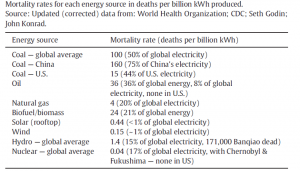
Another concern related to health, is what are the environmental concerns with radiation? This means that coal power plants emit more radioactive particles into the air than nuclear reactors since coal generators let mercury and other heavy metals into the air (Brook et al., 2014). When a reactor does have a serious malfunction a significant amount of radiation could be released. The two plants that have emitted the most radiation was Chernobyl and Fukushima. At Chernobyl, most of the radioactive particles were Iodine 131 and Cesium 137 (Brook et al., 2014). These two particles have a half-life of eight days and 30 years, respectfully. This is significant since the time of contamination of the immediate area will be significantly less potent in just a few months with most of the radioactive-iodine decays. The cesium will stay around for a long period of time, around 120 years. During this time, however, the radius of contamination will slowly shrink since as the distance from the reactor increases the amount of radiation decreases. This is a serious problem that can be remedied by different types of reactors, and more safety features. This includes making reactors that use less potent fuel, having reactors that do not create a positive feedback loop (in the case of Chernobyl) and thoroughly checking equipment.
The next major concern that people have is where will nuclear waste go? Currently the United States government is asking a similar question. This is because there are a few potential spots to store this waste (Nevada and Texas), but no official plan on where to store it. In the meantime, nuclear power plants have safe ways to store spent fuel within the power plant. There are two main ways: fuel pools and dry storage. Fuel pools are exactly as they sound. The spent fuel is put into containers and put at the bottom of a large pool filled with water as pictured in Figure 7 (K. Holt, personal communication Feb 19, 2021). Placing these containers in the pool allows anyone to walk right up to the water’s edge and experience no extra radiation (K. Holt, personal communication Febuary 19, 2021). This is because water is a great substance to absorb radiation. The other way to store spent fuel is with dry cast storage as shown in Figure 8. This storage technique involves creating a large storehouse out of concrete where the fuel is put in canisters and given a large amount of air flow to keep cool. With this contraption, a person can stand right next to the concrete and experience no extra radiation.

Even though there is not a good place to permanently store nuclear waste, it does not mean that there is no use for it. One of the biggest uses of this highly energized spent fuel is to power different reactors. This does not get rid of the nuclear waste completely, but it does decrease the energy in it. This is significant because with less energy in the waste it is less dangerous to humans and our surroundings while also decaying faster (compared to plutonium). There is another use for both types of waste as well: in medicine. Nuclear waste’s primary usage in medicine is to be injected into the body to kill specific cells.
The last major downside of nuclear power is the cost to build a reactor. This is because it takes around 14 billion USD and seven to ten years to build a new nuclear reactor (World-nuclear, 2020). This is due to each reactor being so complex, custom built in each location, and there is not always support for nuclear energy in the government or people. All these things make it difficult for a power plant to be built. This does not include the millions of dollars that are needed to shut down a reactor when the time comes. Some ways that this difficulty could be diminished in the next few years, is the creation of modular nuclear reactors. These reactors are small and can be produced in a factory making them cheaper to own and operate.
Why Education?
Studies have shown that the most effective way to reduce nuclear energy stigma is to educate the young public about its benefits, as well as its challenges (Yim, 2003). Our group has deducted that the most reasonable approach is to present our findings on the benefits and challenges of nuclear energy to children attending high school. We have reached out to the Science & Engineering Curriculum Liaison for Worcester Public Schools to request a presentation to the high school students of Worcester public high schools. We have arranged a meeting with them. If approved, we will give a presentation to the high school students of Worcester about the benefits and challenges of nuclear energy, as well as what they can do to reduce its stigmas. We will present the information found through research as well as the safety measures that are being implemented towards nuclear energy.
Children in the high school age range are the ideal group to educate on the benefits and drawbacks of nuclear energy for a multitude of reasons. Studies have proved that the human brain does not stop developing until the person is in their mid-20’s (Pujol et al., 1993). Since high school students’ brains are still developing, they will absorb information the easiest. High school students also have a multitude of knowledge to gain, so they are in the age of curiosity, where they yearn to learn the most about the outside world as they can. Due to this lack of knowledge, their political attitudes have not yet fully developed, so they will view the presentation and analyze it with views less fixed and more open to being changed. The education system does not mention the benefits of nuclear energy, as this contradicts its teachings about World War II and the disasters that have brought upon severe drawbacks to nuclear energy. However, this system is the largest reason why stigmas spread quickly, and as a result, benefit perception towards nuclear energy is getting more increasingly rare. Learning about the benefits of nuclear energy, as well as how its drawbacks can be improved, will give the students a new view on nuclear energy, and make them aware of the unconscious negative bias others hold on the matter. The most important reason why educating the younger public on nuclear energy is so important is because this is the current age of the pioneers of the future. Presenting the drawbacks to nuclear energy is important in the sense that these future pioneers require knowledge of a problem in order to improve it. However, a pioneer will not be motivated to fix this problem unless they see a long-term benefit, and the long-term benefit is the focus of our presentation.
Our focus is on education after studying the effect of nuclear energy education in France. France has the largest percentage of electricity powered by nuclear energy, at 80% (Lee & Gloaguen, 2015). This is due to France’s educational system, which demonstrates pro-nuclear energy teachings. This means that most of the French public obtains a positive bias towards nuclear energy, and they even believe that France handles nuclear energy better and more efficiently than other countries (Lee & Gloaguen, 2015). Studies have also found that the average French citizen holds more knowledge on the history of nuclear energy in their country, than citizens of other countries on their own respective histories (Lee & Gloaguen, 2015) This insight has led to very little political debate over the validity of nuclear energy, as well as on catastrophic nuclear events, such as Fukushima. These incidents have had little effect on France’s use of nuclear energy. Conversely, the United States’ education system is the opposite, with most US citizens perceiving nuclear energy with a negative lens. If the general United States public learned more about the benefits of nuclear energy, the results could lead to numerous pioneering feats, such as the expansion of nuclear energy, financial support for nuclear energy research and a more effective waste storage and/or usage plan.
Recommendations:
To move forward on destigmatizing nuclear energy, we are going out into the world and teaching the importance that nuclear energy has and will have on the power sector, and the health of our world. If you want to get involved with this campaign here are a few things that you can do. First, research what nuclear energy is and its history and current advances (the reference section is a great place to start). This will both further our goal in educating you about nuclear energy while also allowing you to share your newfound knowledge with the world. Another way to get involved is to join the nuclear movement. Join a pro-nuclear organization, contact a local statesperson, and or attend rallies. This will show our government that we want what is right and healthy for our planet and ourselves. These are two ways to get involved but most importantly keep the conversation going, talk to people about nuclear energy, get them thinking, because once someone is comfortable with an idea it is much easier to convince them that it is good.
See Appendix 3 for the infographic used by the team on Project Presentation Day.
References
Apergis, N., Payne, J., Menyah, K., & Wolde-Rufael, Y. (2010). On the causal dynamics between emissions, nuclear energy, renewable energy, and economic growth. Ecological Economics, 69(11), 2255-2260. https://doi.org/10.1016/j.ecolecon.2010.06.014
Brook, B. W., Alonso, A., Meneley, D. A., Misak, J., Blees, T., & van Erp, J. B. (2014). Why nuclear energy is sustainable and has to be part of the energy mix. Sustainable Materials and Technologies, 1-2, 8-16. https://doi.org/10.1016/j.susmat.2014.11.001
Chater, J. (2005). A history of Nuclear Power. Nuclear Exchange. https://www.nuclear-exchange.com/pdf/tp_history_nuclear.pdf.
Dhar, P. (2020, August 24). ITER celebrates milestone, still at least a decade away from fusing atoms. IEEE Spectrum, accessed Feb 15, 2021. https://spectrum.ieee.org/tech-talk/energy/nuclear/iter-fusion-reactor
De Groot, J. I., Steg, L., & Poortinga, W. (2013). Values, perceived risks and benefits, and acceptability of nuclear energy. Risk Analysis, 33(2), 307-317. https://doi.org/10.1111/j.1539-6924.2012.01845.x
Dewan, L. (2019, April). Save the World with Nuclear Power. TED. https://www.ted.com/talks/leslie_dewan_save_the_world_with_nuclear_power.
Gale. (2020). “Nuclear Energy.” Gale In Context: Opposing Viewpoints, link.gale.com/apps/doc/PC3010999227/OVIC?u=mlin_c_worpoly&sid=OVIC&xid=373bb842.
Hannum, W., Marsh, G., & Stanford, G. (2005). Smarter use of nuclear waste. Scientific American, 293(6), 84-91. https://www.jstor.org/stable/26061261
Ikeda, K. (2010). ITER on the road to fusion energy. Nuclear Fusion, 50(1), 014002. https://doi.org/10.1088/0029-5515/50/1/014002
Kikuchi, M., Lackner, K., & Tran, M. Q. (Ed.). (2012). Fusion Physics. International Atomic Energy Agency (IAEA): IAEA. https://www-pub.iaea.org/MTCD/Publications/PDF/Pub1562_web.pdf
Kim, H., & Song, Y. (2018). The Influence of Social Trust on Public’s Trust in Nuclear related Parties, Benefit and Risk Perceptions, and Acceptance of Nuclear Energy. Korea Observer, 49(4), 665–686. https://doi.org/10.29152/KOIKS.2018.49.4.665
Krikorian, S. (2019, September 04). France’s efficiency in the nuclear fuel cycle: What can ‘Oui’ learn? IAEA Bulletin. Retrieved March 05, 2021, https://www.iaea.org/newscenter/news/frances-efficiency-in-the-nuclear-fuel-cycle-what-can-oui-learn
Konoplev, А., Kanivets, V., Zhukova, О., Germenchuk, М., & Derkach, H. (2020). Mid- to long-term radiocesium wash-off from contaminated catchments at Chernobyl and Fukushima. Water Research, 188, 116514. https://doi.org/10.1016/j.watres.2020.116514
Lee, R., & Gloaguen, S. (2015). Path-dependence, lock-in, and student perceptions of nuclear energy in France: Implications from a pilot study. Energy Research & Social Science, 8, 86-99. https://doi.org/10.1016/j.erss.2015.05.001
Murray, R. (2014). Nuclear Energy: An Introduction to the Concepts, Systems, and Applications of Nuclear Processes. Elsevier Science & Technology.
NRC (Nuclear Regulatory Committee). (2018, June 21). Three Mile Island Accident. Retrieved February 8, 2021, https://www.nrc.gov/reading-rm/doc-collections/fact-sheets/3mile-isle.html
Poinssot, C., Bourg, S., Ouvrier, N., Combernoux, N., Rostaing, C., Vargas-Gonzalez, M., & Bruno, J. (2014). Assessment of the environmental footprint of nuclear energy systems. Comparison between closed and open fuel cycles. Energy, 69, 199-211.
Pujol, J., Vendrell, P., Junqué, C., Martí-Vilalta, J. L., & Capdevila, A. (1993). When does human brain development end? Evidence of corpus callosum growth up to adulthood. Annals of neurology, 34(1), 71–75. https://doi.org/10.1002/ana.410340113
UNSCEAR (United Nations Scientific Committee on the Effects of Atomic Radiation). 2010. Sources and effects of ionizing radiation: UNSCEAR 2008 report to the General Assembly with scientific annexes A and B. New York, United Nations. https://www.unscear.org/docs/publications/2008/UNSCEAR_2008_Report_Vol.I-CORR.pdf
Wang, X., Van der Werff, E., Bouman, T., Harder, M., & Steg, L. (2021). I am vs.we are: How biospheric values and environmental identity of individuals and groups can influence pro-environmental behaviour. Front. Psychol. 12:618956. https://doi.org/10.3389/fpsyg.2021.618956
World Nuclear Association. (2020, March). Economics of Nuclear Power. https://world-nuclear.org/information-library/economic-aspects/economics-of-nuclear-power.aspx.
Yim, M., & Vaganov, P. (2003). Effects of education on nuclear risk perception and attitude: Theory. Progress in Nuclear Energy, 42(2), 221-235. https://doi.org/10.1016/S0149-1970(03)80010-0
